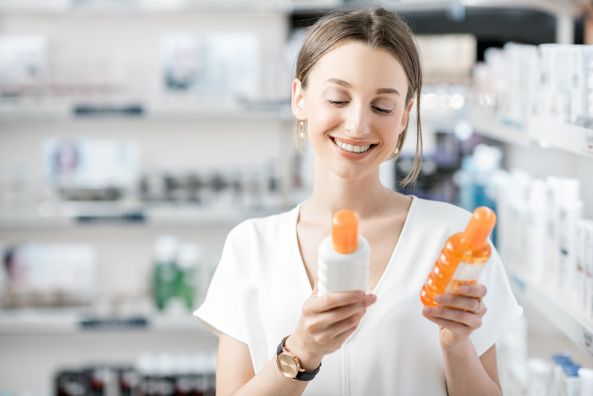Before you stock up on sunscreen for the summer, it’s important to know that not all sunscreen is created equal. There are two categories of sunscreen, based on the specific ingredients that make up the product. Our dermatologists explain the difference between the two types of sunscreen, their unique benefits and factors to consider when making your sun protection selection.
Physical Sunscreen
Sunscreens that contain active ingredients such as zinc and/or titanium are considered physical sunscreens and act as a shield for your skin. UVA and UVB rays bounce off the physical sunscreen, protecting your skin from sun damage. Physical sunscreens are great options for people with sensitive or acne-prone skin as their ingredients typically do not clog your pores and have less risk of causing an allergic reaction. There is no downtime required with this type of sunscreen as it is activated as soon as it is applied.
Physical sunscreens can be a little less water resistant than chemical sunscreen, so you will need to reapply often. These sunscreens can also be thicker and heavier than chemical sunscreens and can leave a white residue behind upon application.
Chemical Sunscreen
Chemical sunscreens protect your skin by absorbing UV rays and then dispersing the rays as heat. Sunscreens are classified as chemical if they contain absorbing ingredients such as avobenzone, octinoxate and oxybenzone1. This sunscreen absorbs into the skin, making it a great option for those engaging in physical or water-based activities while wearing the product. Chemical sunscreens are easier to apply and use less product since they are a lightweight formula.
Plan your chemical sunscreen application accordingly as it takes 15 to 30 minutes to fully absorb into your skin to aid in sun protection. Chemical sunscreens often utilize more ingredients than physical sunscreens to match the high, broad-spectrum protection. The more ingredients that a sunscreen contains, the higher the risk of an allergic reaction or skin sensitivity. For children and pregnant or breastfeeding women, physical sunscreens are recommended.
All sunscreens
Whether you choose to use chemical or physical sunscreen, look for the following keywords on the product:
- Broad-spectrum – this ensures that the sunscreen will block out both UVA and UVB rays
- Fragrance free – sunscreens without a fragrance will help minimize skin sensitivity
- Non-comedogenic ingredients – these ingredients will not block your pores or increase oil production
- SPF 30 – this level of UV protection is recommended by the American Academy of Dermatology. The higher the SPF number, the greater level of protection you will have from sun damage1
Whichever type of sunscreen you choose, both play a crucial role in preventing skin cancers such as melanoma. Learn more about the best sunscreen for you by scheduling an appointment with a dermatologist online or by calling your preferred location.
1IS SUNSCREEN SAFE? (2019, February 21). In American Academy of Dermatology Association. Retrieved from https://www.aad.org/public/eve…
Health Topics:







